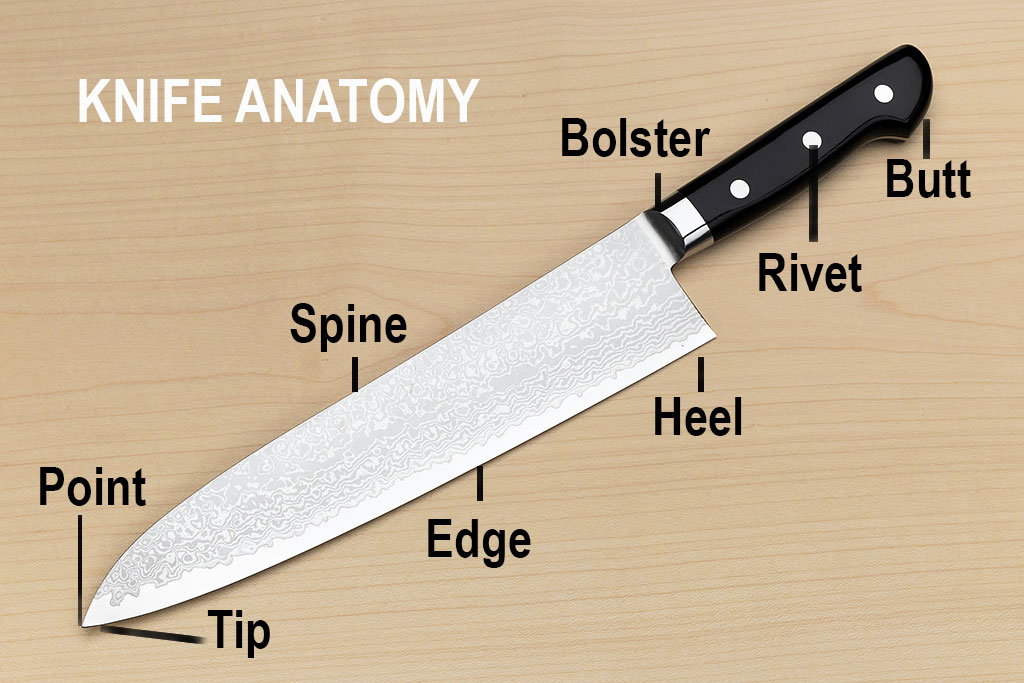The chef's knife is most likely the most crucial instrument in a cook's arsenal. And given how much time it spends in your hand, it's absolutely worth investing in a decent one.
Many individuals advise buying "the best knife you can afford." But it won't assist you much until you know what makes one knife superior to another. Otherwise, you're simply purchasing the most costly knife you can afford.
The finest knives are made from a single piece of steel that spans the length of the blade. Continue reading for a short rundown of the many components of a chef's knife, what they perform, and why they're essential.
Point
The point is the part of the blade where the tip and spine meet and is most often used for piercing and scoring.
Edge
The edge of a knife is the actual functioning portion. Edges can be ground to a variety of profiles depending on the intended usage of the knife. Chisel, Hollow-Ground, V or Flat-Ground, Convex, Compound, or Serrated edges are all possible. Some edges, such as half Hollow-Ground and half Serrated, can even have numerous bevels. Depending on what the knife is used for, the edge might be crucial. Hollow-Ground will give you a very fine, razor-sharp edge, but it will be fragile and will not withstand severe cutting. Many good chef’s knives, slicing and boning knives, fillet knives, and pocket knives have hollow-grinds. Flat Ground edge is robust and ideal for cutting. It can retain a decent edge for most jobs, but not a super-fine edge for extremely clean slicing. Flat Grinds may be found on Meat Cleavers, Axes, and Machetes. Chisel tips are commonly found on tools. Convex and compound grinds are a middle ground between hollow and flat grinds. Serrated edges are prevalent on many kitchen knives, and they offer excellent shearing strength for making clean cuts through difficult materials such as seat belts and gristle. Some knives may even have a Hollow grind on the first half of the blade and a Serrated grind on the second half of the blade. This combo appeals to certain people.
Tip
The first third of the edge of a knife is generally regarded to be the tip, which includes the point. This area of the blade is utilized for slicing and fine cutting.
Heel
The heel is the broadest section of the knife's edge and is located at the back of the blade. It's the blade's strongest point, and it's perfect for slicing tough vegetables.
Spine
The rear of the blade, or the middle if it's a double-edged knife. The spine is the thickest portion of the blade and gives the edge strength. The thicker the spine, the more powerful the blade. The thickness of the spine is also significant since it affects the knife's balance. Blade-heavy knives are fantastic for chopping but might be awkward to use for delicate slicing. Handle-heavy blades are ineffective for chopping but excel at delicate and precise slicing. Texturing around the last inch or so of a spine, near the handle, known as "jimping," enables placing the thumb on the back of the blade for greater control while making complex and very delicate cuts.
Bolster
The bolster is a strong steel shoulder placed at the front of the handle where it meets the spine or top (non-cutting) edge of the blade. The bolster, in addition to stabilizing the knife, protects your fingers from sliding while you work, minimizing hand strain and blisters.
A bolster will not be found on every chef's knife. A bolster shows that a knife was forged from a single piece of steel rather than stamped from a roll of sheet metal. In general, stamped knives are inferior to forged knives. The thickness of a bolster indicates the thickness of the initial piece of steel—the thicker, the better.
Rivet
Rivets are the elevated, cylindrical studs that hold the handle to the tang section of the knife. Knives with hardwood handles are commonly constructed in this manner. If rivets are present, ensure that their tops are smooth and do not protrude from the handle in any way.
Tang
This is the source of your knife's strength, stability, and balance. The metal portion of the blade that continues into the handle is known as the tang. Depending on the knife, the tang may extend only partially through the handle (a partial tang) or all the way to the end of the handle (a complete tang) (a full tang).
Butt
The butt is the back end of the knife handle.
Blade
The blade is the knife's primary body, which comprises the point, tip, edge, spine, and heel. The blade's size, form, and material are the most distinguishing features of the knife.
The greatest chef's knives are constructed of high-carbon stainless steel, which is a highly strong metal that retains its edge for a long time and will not discolor or rust like regular carbon steel.
To be sure, blades manufactured of common carbon steel are not always inferior. Some cooks prefer them because the comparatively softer metal makes sharpening simpler. Of course, they become duller more quickly as well.
Chef's knives are measured in inches, with typical lengths ranging from 8" to 12".
Handle
The handle is the part of the knife that extends from the bolster to the butt. It varies in shape, weight, and material.
Many materials may be used to make handles, including micarta, abalone, turquoise, various types of wood, plastic, rubber, leather, and polymers. The shape of a knife's handle can influence how easily it can be utilized for a certain purpose. A handle can be straight or curved, and it might include finger grooves.



POST COMMENTS
0 COMMENT(S)